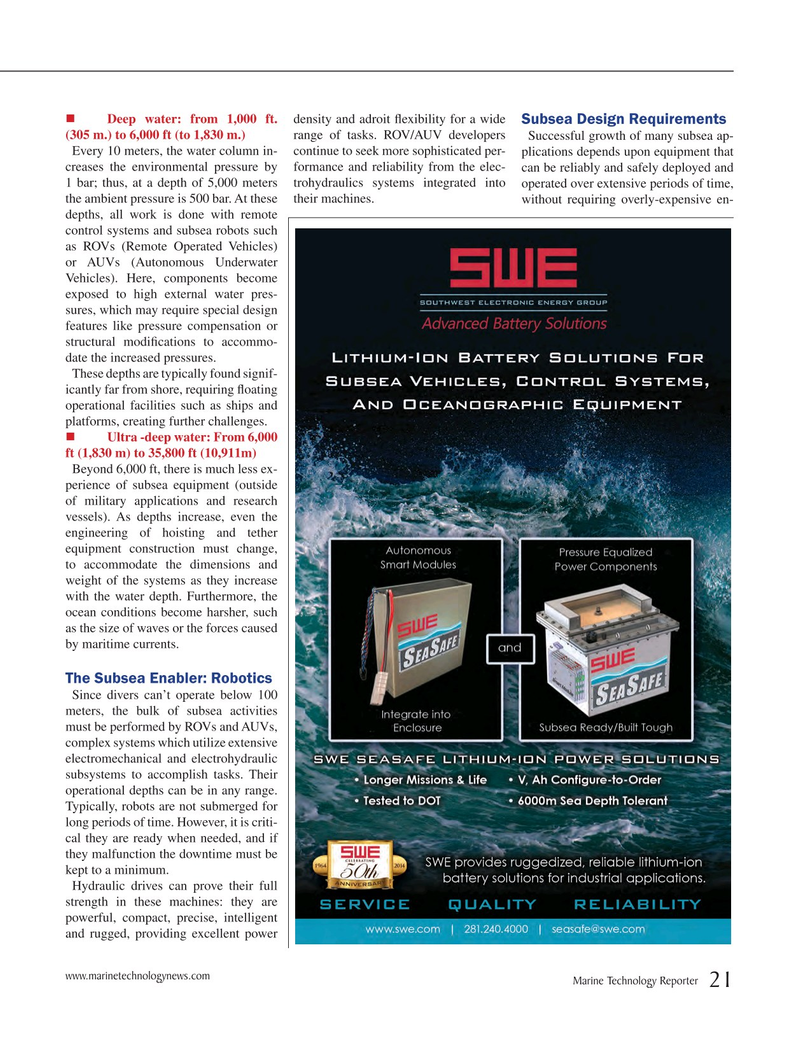
Page 21: of Marine Technology Magazine (April 2015)
Offshore Energy Annual
Read this page in Pdf, Flash or Html5 edition of April 2015 Marine Technology Magazine
? Deep water: from 1,000 ft. density and adroit ? exibility for a wide
Subsea Design Requirements (305 m.) to 6,000 ft (to 1,830 m.) range of tasks. ROV/AUV developers Successful growth of many subsea ap-
Every 10 meters, the water column in- continue to seek more sophisticated per- plications depends upon equipment that creases the environmental pressure by formance and reliability from the elec- can be reliably and safely deployed and 1 bar; thus, at a depth of 5,000 meters trohydraulics systems integrated into operated over extensive periods of time, the ambient pressure is 500 bar. At these their machines. without requiring overly-expensive en- depths, all work is done with remote control systems and subsea robots such as ROVs (Remote Operated Vehicles) or AUVs (Autonomous Underwater
Vehicles). Here, components become exposed to high external water pres- sures, which may require special design features like pressure compensation or structural modi? cations to accommo- date the increased pressures.
These depths are typically found signif- icantly far from shore, requiring ? oating operational facilities such as ships and platforms, creating further challenges. ? Ultra -deep water: From 6,000 ft (1,830 m) to 35,800 ft (10,911m)
Beyond 6,000 ft, there is much less ex- perience of subsea equipment (outside of military applications and research vessels). As depths increase, even the engineering of hoisting and tether equipment construction must change, to accommodate the dimensions and weight of the systems as they increase with the water depth. Furthermore, the ocean conditions become harsher, such as the size of waves or the forces caused by maritime currents.
The Subsea Enabler: Robotics
Since divers can’t operate below 100 meters, the bulk of subsea activities must be performed by ROVs and AUVs, complex systems which utilize extensive electromechanical and electrohydraulic subsystems to accomplish tasks. Their operational depths can be in any range.
Typically, robots are not submerged for long periods of time. However, it is criti- cal they are ready when needed, and if they malfunction the downtime must be kept to a minimum.
Hydraulic drives can prove their full strength in these machines: they are powerful, compact, precise, intelligent and rugged, providing excellent power www.marinetechnologynews.com
Marine Technology Reporter 21
MTR #3 (18-33).indd 21 MTR #3 (18-33).indd 21 4/6/2015 10:35:13 AM4/6/2015 10:35:13 AM

 20
20

 22
22
